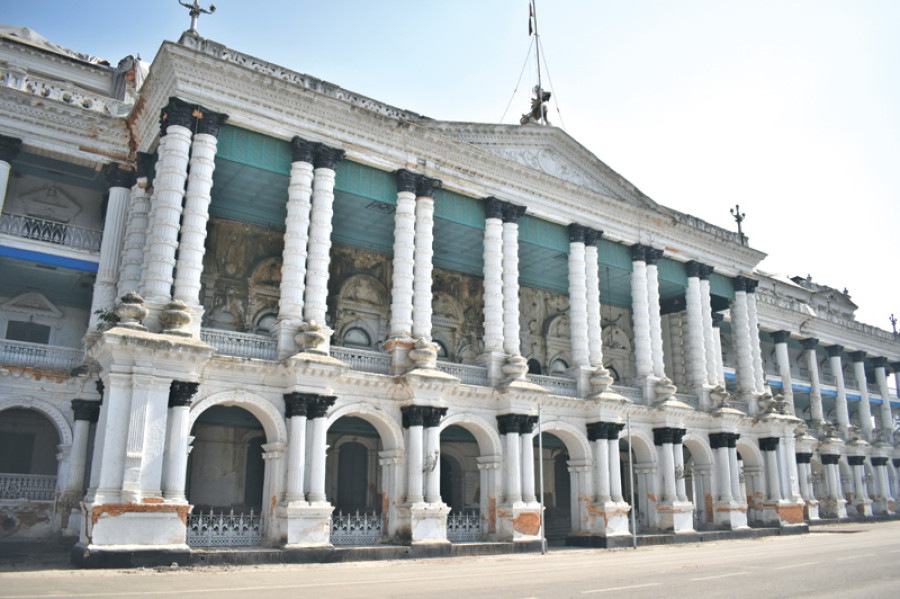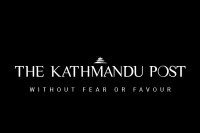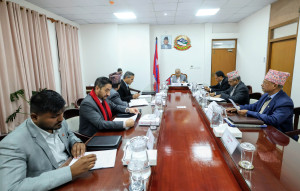Miscellaneous
The forgotten era
When thinking of classic Nepali architecture, it is usually the detailed wood carvings and brick temples of the Newar architectural style, which comes to mind.
Freja Sonnichsen
When thinking of classic Nepali architecture, it is usually the detailed wood carvings and brick temples of the Newar architectural style, which comes to mind.
While this is a significant part of the cultural history that Kathmandu is home to, there is an architectural time period which has been forgotten from the streets of Nepal’s Capital for over 70 years.
The buildings are those of the neoclassical design, first built in Nepal during the 1860s and which dominated the architectural style for the next 100 years. Today, the remaining palaces and buildings of this architectural period are left out of the Ancient Monument Preservation Act of 2013, leaving them unprotected against deterioration. And it shows: The once grand walls of the Singha Durbar itself, perhaps the most iconic of Nepal’s neoclassical buildings, is in a critical condition.
Professor of architecture at Tribhuvan University and General Secretary of Society of Nepalese Architects Sudeep Paudyal is attempting to save these buildings by handing the government a memorandum of the terms of which constitutes protection for a building.
“According to the Ancient Monument Act, if the building has had a lifetime of more than 100 years, then it is recorded as a historical building,” said Paudyal.
As the majority of the neoclassical buildings were built in the early 1900’s, for Paudyal, the debate of whether they should be protected has a simple resolve: “According to national law, (they) should be a recorded building(s).”
If the buildings were to become protected, they would fall under the care of the Department of Archaeology (DoA), who themselves are hoping they will be named heritage sites. According to an anonymous deputy within the department, each historical or cultural building should be registered within the related government office declared by the government, however, this is currently not being implemented.
Out of approximately 40 neoclassical buildings in the Kathmandu Valley, Paudyal has prioritised three in his memorandum to the government to become protected by the Ancient Monument Preservation Act. These three buildings are the Singha Durbar, the Kaiser Library, which is the first public library in Nepal, and finally the Bagh Durbar, the current office of the Kathmandu Metropolitan City. All of these palaces have a significant historical meaning, and in the case of the Kaiser Library and the Singha Durbar, there were already reconstruction plans set in action before the 2015 earthquake.
“[After becoming a republican country in 2008], the new Prime Minister [Girija Prasad Koirala] took oath at the Singha Durbar,” said Paudyal, giving an example of the building’s historical context. “Not only that, at that time when the Singha Durbar was built, it was a complex building with 1700 rooms. This was the largest palace in Asia at that time, and this was done by Nepalis.”

For author of Temples of Nepal Valley and retired architecture professor Sudarshan Raj Tiwari, there is more to the debate of whether a structure should be named a heritage than just the amount of years the building has been standing or what design it is architected in.
“We want to make this a heritage not because of the neoclassical architecture, but because it’s a neoclassical building that we built ourselves,” said Tiwari.
Part of the debate of whether the buildings should become preserved under the Preservation Act is that the style is not original to Nepal, but was rather imported from Europe by the Rana family. In addition to this, the Rana reign is not perceived as a favourable time in Nepali history, which could have an influence on how the palaces are perceived.
“The Ranas were very autocratic, they took a lot of tax out of us, but that’s how the palaces were built and they couldn’t have done it otherwise,” said Tiwari. “The thing is, we were there, and they were there, and we passed through it [that historic period] and there are many things to remember about that. Memories are not just good memories, memories are memories.”
For supporters of the memorandum, such as Tiwari, the buildings are more so a testament to the skills of the Nepali constructors than to the ruling of the Ranas.
“It’s built by local people, it’s an example of how the people who were building temples were also able to build a neoclassical building with the standards that could last a hundred years,” said Tiwari.
With nearly every building in Kathmandu needing some degree of restorative attention, especially after the 2015 earthquake, it can be difficult to prioritise which gets attention and which does not. The Department of Archaeology has made a classification system to organise the 800 different monuments in Nepal’s 72 districts, classified by the era the monuments were built in. The era of the neo-classic buildings, also known as the Rana Period, fall under category B, whereas the UNESCO world heritage sites fall under A and modern buildings under C.
As the post-earthquake reconstruction efforts remain focused on the rebuilding of just category A monuments, the recent petition and discussions over the fate of the iconic Singha Durbar serve as a reminder that other equally important architectural achievements should not fall by the wayside. After all, as Tiwari put it, memories are memories.
Sonnichsen is a Danish national currently working as a freelance journalist in Nepal




 14.12°C Kathmandu
14.12°C Kathmandu










